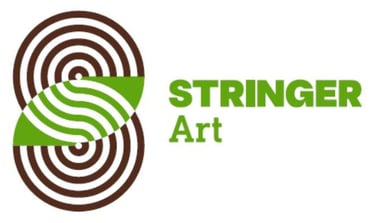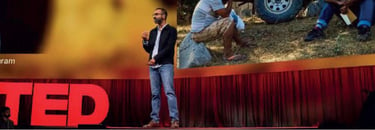

“Anjan Sundaram shines a light on inspirational humanity in some of the world’s most important wars, for which he has been called one of the great reporters of our age.” — TED.com
Origins of Stringer Art
Stringer Art originates in my personal artistic practice that helps me process the impact of the wars I covered. For years, I kept my art based on my war correspondence private. Stringer Art was born from the idea that art can help heal journalists from trauma, while also bringing new audiences and witnesses to the world's most urgent crises.
My personal artistic process is intimate: I took my clothes off my body--clothes such as my underwear that I had worn into war zones--which I photographed, and used to depict the wars that I had covered. It felt like I was taking the trauma off my body and throwing it on the canvas. I felt relief.
Stringer Art complements the philanthropic mission of The Stringer Foundation, which was conceived during conversations with philanthropists after my MainStage talk at TED 2024. Stringer Art addresses the crisis in global journalism by initiating pioneering conversations between journalism and art. Journalists become artists who shine a light on the most vulnerable populations in the world while also performing their healing from the trauma they're left with after reporting on global crises.
Stringer Art Mission
Stringer Art is a studio that has pioneered the making of "Journalism as Art," which transforms the journalist's subconscious into public and private art by depicting the global crises that the world, and we, turn away from personally and collectively.
Stringer Art also performs the personal healing of journalists, other humanitarian workers, and communities on the frontlines of global but underreported conflict. In doing so, Stringer Art offers healing, beauty, unease, and paths to action to global audiences. This art gives journalistic narratives new form and fundamentally changes how we react to global crises.
Stringer Art makes us all witnesses to stories woven into art, connecting us in deep and engaging ways to the world's problems that need fixing, via the personal imagery that heal journalists. It brings together a multidisciplinary community of journalists, artists, artistic directors, technologies, creatives, curators, and gallerists.
Stringer Art Manifesto
In “Journalism as Art,” the journalist becomes a subjective, non-authoritative, and emotional artist -- in contrast to journalistic tradition -- emphasizing their identity, their journeys of learning, and engagement with global communities, while introspecting and expressing the emotions they are left with from their journalism, which often lack adequate means of expression within mainstream journalistic tradition.
The positionality, identity, and personal trauma of the reporter, and the costs of their reporting on themselves and their personal lives, has only begun to be broached in journalistic circles, allowing for artistic expression to be considered a fundamental part of the journalistic oeuvre, and a necessary means of expression for the journalist-artist. In an age of disinformation, and distrust of journalists, journalism is increasingly marginal in its impact on audiences. This is partly because journalists are seen to break their own ethical codes of impartiality and bias.
“Journalism as Art” argues that impartiality and objectivity were impossible goals to begin with, and that an ideal medium of expression between journalists and audiences is artistic. “Journalism as Art” expands the boundaries of what is considered journalism, creating the role of the journalist-artist with a wider role to play within society in their new avatar, modes of expression, and conversations.

